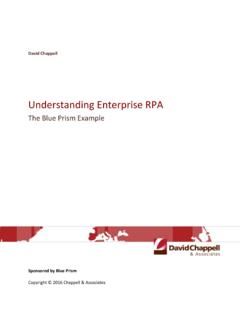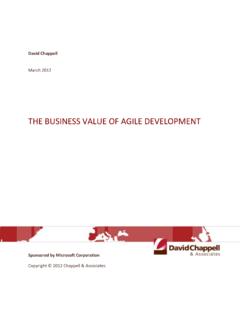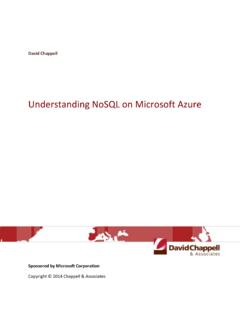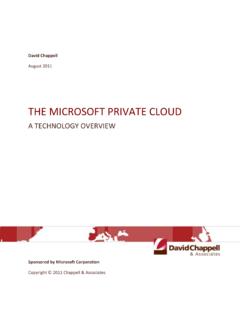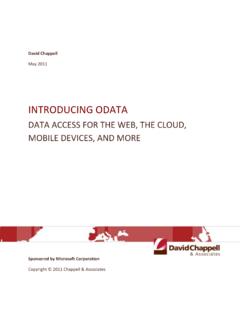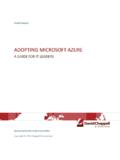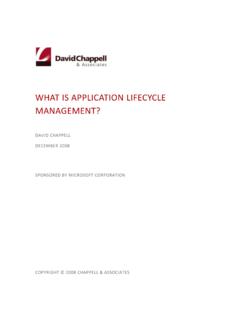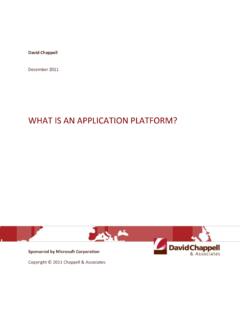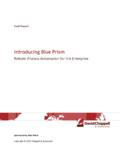Transcription of How SaaS Changes an ISV's Business - David …
1 HOW saas Changes AN ISV S Business A GUIDE FOR ISV LEADERS Sponsored by Microsoft Corporation Copyright 2012 Chappell & Associates 2 Contents Understanding the Move to saas .. 3 Assessing saas ..3 Benefits and risks for Customers ..4 Benefits and risks for ISVs ..5 saas or Not? A Simple Decision Tree for ISVs ..6 How saas Changes Your Business .. 7 Target Customers ..7 Pricing and Revenue ..8 Pricing Options ..8 Revenue Accrual in saas Applications ..8 Measuring Success: Monthly Recurring Revenue ..10 The Sales Process ..10 The Customer Buying Decision ..10 Sales Commissions ..12 Working with Partners ..12 The Impact of Average Selling Price ..13 Marketing ..15 Customer Support.
2 15 Operations ..16 Software Development ..17 Organizational Structure ..17 Choosing a Platform for Your saas Application .. 19 Final 20 About the Author .. 20 3 For independent software vendors (ISVs) with an established on-premises Business , the rise of Software as a Service ( saas ) brings both technology Changes and Business Changes . Most often, the technology Changes get the lion s share of the attention. After all, transforming an existing on-premises application into reliable, scalable software capable of supporting many customers simultaneously is not a small thing. Challenging as this transformation is, however, the truth is that the Business Changes are harder. The move to saas goes to the heart of what it means to run a software Business , changing pricing, the sale process, and much more.
3 Despite the magnitude of these Changes , there are two main reasons why you might decide to adopt saas : You might be able to grow your Business with saas . Perhaps you can expand your customer base by going after smaller firms, or maybe you can enter an entirely new market, riding the saas wave to success in a new area. You might need to defend your Business against saas competitors. The move to saas can let new firms enter your market. One visible example of this is Google Apps, which use the paradigm shift of saas to attack Microsoft s established on-premises businesses in email, document creation, and more. Creating your own saas offering, as Microsoft has done, might be the only effective way to deal with this new competition.
4 Whatever your reason, adding saas offerings to your product portfolio requires changing how you do Business . The goal of this paper is to help you understand these Changes and make better decisions about adopting saas in your organization. Understanding the Move to saas Every ISV leader needs to understand the basics of what saas brings. You also need to make good decisions about how, when, or even whether your firm should embrace this approach. This section looks at these fundamental aspects of the move to saas . Assessing saas Like most new things, saas brings benefits and risks . ISV leaders need to examine these from two perspectives: the benefits and risks for your customers why they do and don t buy saas applications and the benefits and risks for your company.
5 From ISVs to CSVs Traditional ISVs aren t the only ones offering saas applications today. It s common for software start-ups to choose this approach, for instance, and some system integrators are also taking advantage of this platform shift to provide cloud-based applications. Even organizations that were traditionally end users of technology are getting into the act, using their own specialized knowledge to create new saas offerings. It s useful to think of all of these groups, together with existing on-premises ISVs that embrace saas , as making up a broader category of cloud service vendors (CSVs). The rise of the cloud is changing many things about the traditional Business of selling packaged software, including the terminology we use and how we categorize the players.
6 Thinking broadly in terms of CSVs rather than traditional ISVs can help you get a better feeling for what s happening. 4 Benefits and risks for Customers Organizations that buy saas applications are diverse, ranging from two-person firms to global enterprises. Yet the things they like and don t like about saas tend to be much the same. Figure 1 summarizes the benefits and risks of saas from the perspective of your customers. saas Benefits for Customers saas risks for Customers saas allows faster deployment, because no on-premises installation is required. Rather than wait weeks or months for software to be deployed and configured on its own servers, an organization can directly access the application in the cloud.
7 Using saas requires trusting an outside provider for the application s availability and security. Most saas providers don t let their customers physically examine the details of how they provide security. Instead, those customers must learn to trust the saas provider, something that can take time. saas typically offers usage-based pricing, such as per user per month, letting customers pay only for what they use. Rather than estimating its needs, then buying a license in advance, an organization can pay only for what it actually uses. saas can raise legal/regulatory concerns with storing data outside the customer s premises. Many countries have laws and regulations about where some kinds of data can be stored and how it must be handled.
8 saas applications can run afoul of these, especially when the saas application s datacenter and the customer are in different countries. A saas application has less financial risk than an on-premises application. Most cloud applications offer try-before-you-buy options, so a customer can be sure the application has Business value before paying for it. Pay-as-you-go pricing also brings less risk than a typical large up-front license fee. A saas application can limit customization if many customers share a single multi-tenant application. Multi-tenancy, with multiple customers using the same instance of software, lowers costs, but it also constrains how different that software can appear to those customers.
9 While saas vendors often provide configuration options, a licensed on-premises application is typically more customizable. saas reduces the need for on-premises resources, such as servers and IT staff. Because the software runs in the cloud, customers don t need to invest in the hardware and people to run and manage the application on premises. saas applications can be harder to integrate with existing on-premises applications. Connecting applications within a single datacenter is often challenging. When some of those applications are running in the cloud, integration can get even harder. saas applications offer easier upgrades, with no on-premises software to update. Instead, the saas provider deploys upgrades to a centrally managed copy.
10 This makes it easier for customers to get the benefits of new features added to an application. saas can have lower performance than on-premises applications. This issue appears most frequently when network bandwidth between the customer and the saas application s datacenter is limited, and so how much it matters commonly depends on geography. Figure 1: saas applications bring both benefits and risks for customers. 5 As this list suggests, saas isn t right for every application or every customer. Some kinds of applications, such as email, are rapidly moving to saas the benefits commonly outweigh the risks . Others, such as those that work with tightly regulated data or require a great deal of customization, are remaining on-premises (and they might stay there forever).
